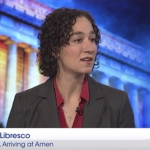Apparently someone set up a cross on a courtyard at school and replaced the letters INRI (Jesus of Nazerene, King of the Jews in Latin) with ROFL. I don’t have many details; all the reporting is happening on the op-ed page, and there are no pictures or other context. I’m going to run down the op-eds that have been written before I give my thoughts.
“An insulting prank and hypocritical response” — Jordon Walker
Walker broke the story and rebuked the campus for not treating anti-Christian displays with the same gravity and anger that previous anti-semitic and racist graffiti had provoked.“Good Friday and the ROFL cross” — Garrett Fiddler
Fiddler reminded readers that the original inscription of INRI nasty and mocking. Whether the display was intended to give offence or update the Passion story, Fiddler focuses on Jesus’s defeat of death on Easter and his victory over mocking in all ages.“Censoring Speech at Yale” — Nate Zelinsky
Zelinsky argues that Yale should not clamp down on offensive speech of any kind. Currently, he argues, the administration only polices speech that is targeted at minority groups.
As you may recall from my series of posts on P.Z. Myers’s desecration stunt, I don’t approve of blasphemy for the sake of blasphemy. I think it’s unproductive and unkind to boot. But immoral isn’t the same thing as illegal, even on a college campus.
I doubt Yale will be able to find the kid who put up the ROFL cross or the student who burned a pro-LGBT poster recently. If they were identified, I don’t see a reason the school administration should do more that tell the culprits that their actions were unworthy of them and explain how the administrators and other students have been hurt.
There’s a big difference between offensive speech and threatening speech. Zelinsky analogizes the ROFL cross to the chants of DKE pledges outside the Women’s Center (“No means Yes! Yes means Anal!), but this is a false equivalence. The DKE pledges were condoning or threatening rape en masse just a pane of glass away from the ostensibly safe space for women on campus. Christians might be offended or saddened by the recent display, but they would have little reason to be afraid.
Some of the commenters on the surprisingly nasty thread following Walker’s piece argued that no speech was truly threatening or intimidating if it was directed at Christians in the United States or at any other powerful, majority group. I disagree. There is probably a higher bar for intimidation, when a group is generally secure, but insisting the group cannot be hurt or that individual members can’t be intimidated.
I’m sorry that someone was being unproductively offensive, but I’m more upset by the tenor of the discussion that followed
















